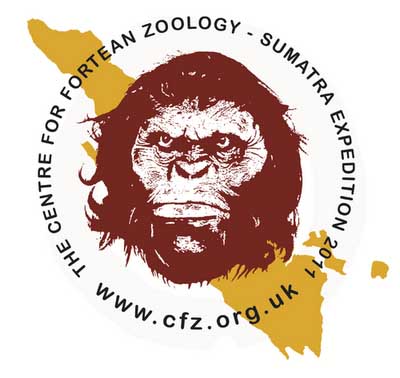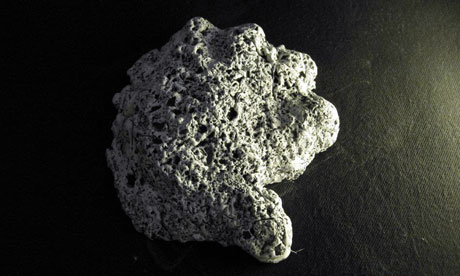Orang Pendek Expedition 2011 Report
Posted by: Craig Woolheater on October 9th, 2011

Richard Freeman describes last month’s expedition in the jungles of Sumatra on the trail of the orang pendek

Artist’s impression of an orang pendek. Photograph: Ant Wallis/Centre for Fortean Zoology
Have we found evidence of the elusive orang pendek?
Even in this age of satellite mapping and global positioning, there remain “lost worlds” where few humans tread and where species of animal unrecognised by science live. Kerinci Seblat National Park in West Sumatra is one such place. The size of a small country, its dim, steamy interior has never been explored properly. Last month I returned to these jungles for the fourth time to track an elusive and, as yet, unrecorded species of ape known to the locals as the orang pendek or “short man”.
This year’s expedition was the largest of its kind ever to visit the area. It consisted of two teams. The first, made up of Adam Davies (expedition leader at the Centre for Fortean Zoology), Dave Archer, Andrew Sanderson and myself, would concentrate on the highland jungles around Lake Gunung Tujuh. The second team, consisting of Dr Chris Clark, Lisa Malam, Rebecca Lang, Mike Williams, Jon McGowan and Tim De Frel would have their base in the “garden” area – the more open, semi-cultivated land that abuts onto the true forest. According to local reports, the creature has been sighted here on a number of occasions when it comes down to raid crops such as sugar cane.
Before team one left, our guide Sahar introduced us to an eyewitness called Pak Entis, who claims to have seen an orang pendek in the garden area in April. He described it as around three feet tall but with massive shoulders and chest. He pointed to a piece of washing on a line to indicate the colour of its hair – a mid-tan. It had an ape-like face and walked upright on two legs while swinging its arms. Upon noticing Pak Entis it became alarmed and raised its hands above its head uttering a “hoo-hoo” sound and moved quickly away. It was in view for around a minute.
We climbed the jungle-swathed lip of Lake Gunung Tujuh, the caldera of an extinct volcano, and crossed by canoe. After setting up camp we began trekking into the jungle. Generally, we would trek for several miles and then stop and have long sessions of quiet observation.
We also set up motion-sensitive camera traps. We found chewed ginger plants and rattan shoots, both thought to be favourite foods of the orang pendek. DNA has never been recovered from samples like this, unfortunately, and these had been exposed to the rain for quite some time.
On one trek, on the far side of the lake – an area with damper, thicker jungle – Sahar’s brother John found a print next to a rotting log that had been ripped apart. Orang pendek have been seen feeding off grubs in such logs. The print was cast by Andrew Sanderson using quick-drying dental plaster. Close by, Sahar found a number of hairs, which Adam preserved in ethanol for later laboratory analysis.Richard Freeman

Cast of a possible orang pendek handprint found near a rotting log that had been ripped apart. Photograph: Andrew Sanderson
Back at the camp, I had a closer look at the cast as it was cleaned. It was clearly a handprint rather than a footprint. The palm was rounded, the thumb short and almost triangular, and the fingers were thick and sausage-shaped. The structure was quite unlike that of the Sumatran orangutan with its long thin fingers and almost vestigial thumb. It was more like the handprint of a small gorilla, but with a somewhat rounder palm.
The next few days after the cameras had been set up consisted of rounds of tracking and observation. We found many tiger prints and scrape marks in the area, and also the remains of two Malayan tapirs killed by tigers.
Sahar told us of another creature that may inhabit the deep jungles. The orang kardil, or “tiny men”, are said to be a race of humans around three feet tall, quite distinct from the larger, simian orang pendek. The orang kardil apparently go naked in the jungle, are hairless except for their heads and hunt with poisoned bamboo spears. They are notorious for stealing food.
In 1981, Sahar’s late father and a friend were trading rice in a remote area five days’ trek from his village. They were travelling through a valley beyond the mountain of Bukit Candi Alus and the Batang Asa River. According to Sahar, the friend killed one of these “tiny men” who had raided their supply of rice. In retaliation several orang kardil speared him to death.
The orang kardil call to mind Homo floresiensis, from the Indonesian island of Flores, now thought by some to be late-surviving Australopithecines. Could two unknown primates lurk in Kerinci: an undiscovered pongid and a surviving Australopithecine? As far as I am aware, sightings of the orang kardil have not been reported for decades, but the park is very deep and almost no one ventures right into the interior.
In the lowlands, the second team had close encounters with tigers prowling the camp at night, and floodwaters almost washed away their pondok (a temporary shelter). They interviewed a farmer who said an orang pendek had broken into his shed one night to steal sugar cane. The animal apparently ripped away planks to get at the stored crop.
In the garden area, there is some evidence that the orang pendek may be losing its fear of humans due to the lure of easy food. I believe it is here that we are now most likely to have a close encounter with the creature and capture it on film.
We have examined the many photographs from the camera traps and it seems all we caught were insects, rainfall and a solitary bird. This is hardly surprising given they were only up for nine days. However, plans are afoot to establish a set of camera traps in the park on a permanent basis and have them checked once per month. We hope to get this project off the ground in 2012.
The hairs will be sent off for DNA testing to Professor Bryan Sykes, Professor Todd Disotell, Dr Tom Gilbert and Lars Thomas, but we won’t get the results for a few months. Copies of the cast will be sent to leading primatologists.
Looking at Kerinci Sablat National Park on a map, I see that we have only ventured into its very edges, like dipping one’s toes into the sea. If I return, I would like to take a party deep into the interior of the jungle. There are other stories here, too, of giant pythons and of an aggressive big cat resembling a prehistoric homothere and known locally as the cigau.
I would also like to stake out and bait some of the garden area that seems of increasing interest to the orang pendek.
We now play a waiting game for the results of the hair analysis. I fervently hope that some of them had follicles with uncorrupted DNA. For the time being, however, the fastness of the jungle is keeping its strange inhabitants a secret.Richard Freeman
Richard Freeman is zoological director of the Centre for Fortean Zoology. Orang-pendek: Sumatra’s Forgotten Ape by Richard Freeman is published later this year by CFZ Press.
About Craig Woolheater
Co-founder of Cryptomundo in 2005.
I have appeared in or contributed to the following TV programs, documentaries and films:
OLN's Mysterious Encounters: "Caddo Critter", Southern Fried Bigfoot, Travel Channel's Weird Travels: "Bigfoot", History Channel's MonsterQuest: "Swamp Stalker", The Wild Man of the Navidad, Destination America's Monsters and Mysteries in America: Texas Terror - Lake Worth Monster, Animal Planet's Finding Bigfoot: Return to Boggy Creek and Beast of the Bayou.









Great discoveries are often made by people who are appreciating & deeply evaluating what is in front of them.
I find it an odd coincidence that if I do a search for homothere on bing, two pages come up about so called lucy. It might be a nice exercise the next time anyone goes into the land of orangutans and tigers, to try and enjoy them a little more…
I wished the DNA research would come out sooner. I have the same reaction to the DNA testing of the Sasquatch-the-Quest evidence, which will (hopefully) come out soon.
Hopefully in the future a type specimen of Orang Pendek will be cataloged soon. Even DNA won’t convince most scientists.